Analysis of Wesfarmers' Sustainability Report for Australasian Awards
VerifiedAdded on 2022/10/10
|9
|2241
|21
Report
AI Summary
This report analyzes Wesfarmers Limited's success in the Australasian Reporting Awards, specifically focusing on its sustainability efforts and strategic decisions. The report delves into the company's operational strategies, supply chain and logistics systems, and how these elements contribute to achieving desired business outcomes. It examines both internal and external factors influencing Wesfarmers' operations, utilizing conceptual models to understand the ethical implications of its day-to-day and strategic decisions. The report highlights the company's commitment to sustainability goals, including environmental conservation and responsible human resource management. The analysis emphasizes how Wesfarmers' approach, which prioritizes profits as a tool rather than the primary goal, has led to positive relationships with stakeholders, including employees, the government, and investors, ultimately contributing to its position as a leading company in its operational jurisdiction. The report also discusses how the company's focus on demand-driven models, operational efficiency, and taxation regulations supports its sustainability priorities and contributes to its success in the Australasian Reporting Awards.
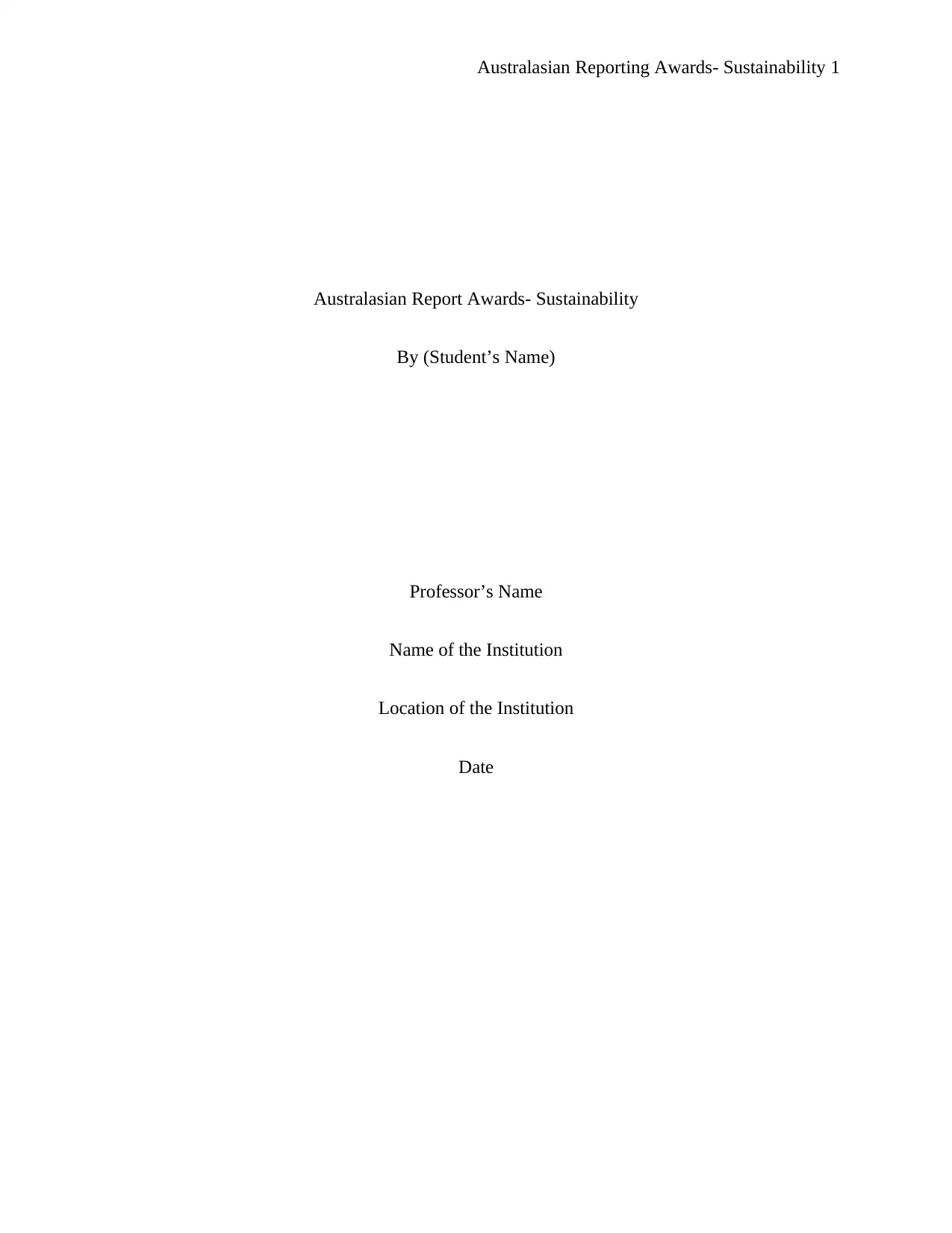
Australasian Reporting Awards- Sustainability 1
Australasian Report Awards- Sustainability
By (Student’s Name)
Professor’s Name
Name of the Institution
Location of the Institution
Date
Australasian Report Awards- Sustainability
By (Student’s Name)
Professor’s Name
Name of the Institution
Location of the Institution
Date
Paraphrase This Document
Need a fresh take? Get an instant paraphrase of this document with our AI Paraphraser
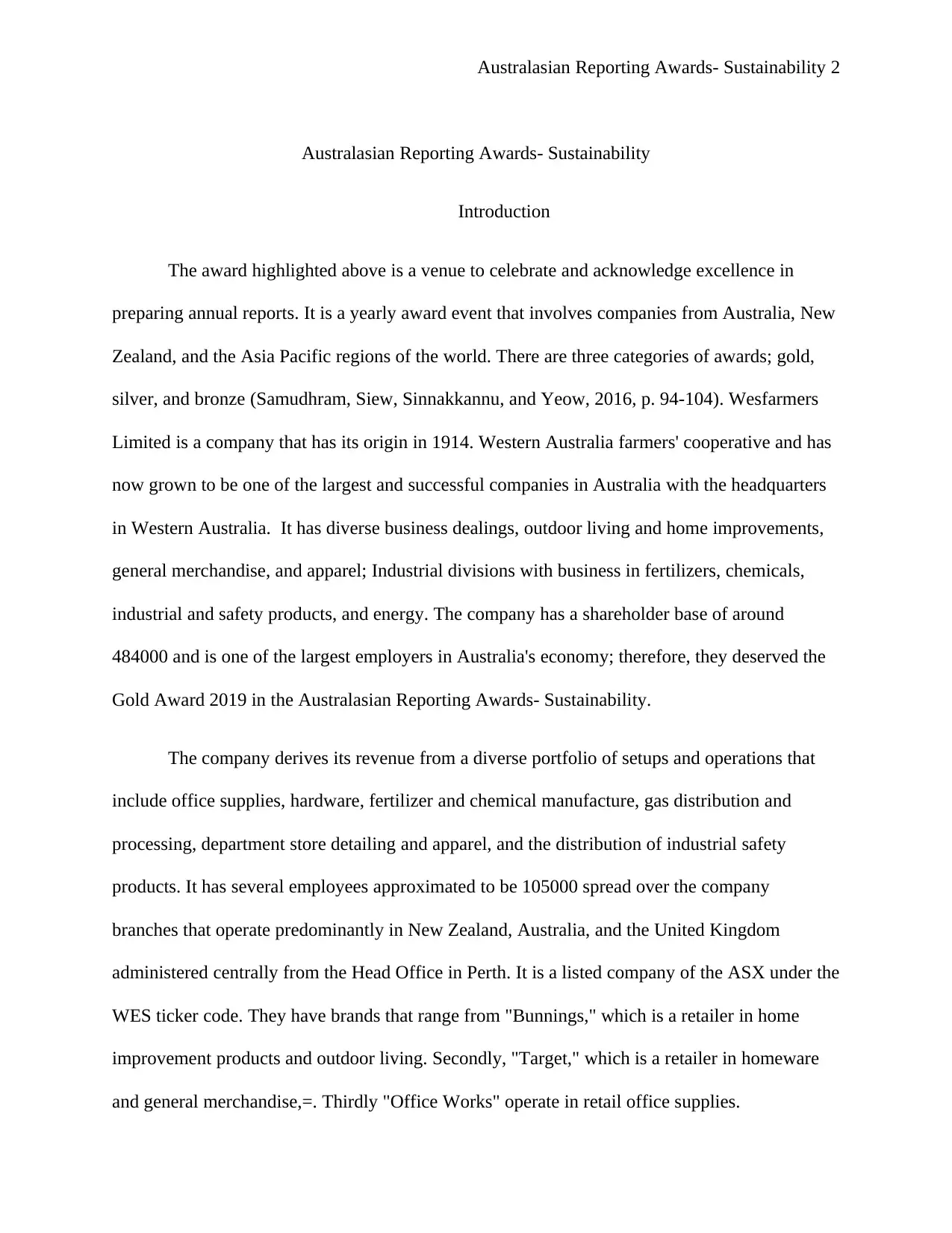
Australasian Reporting Awards- Sustainability 2
Australasian Reporting Awards- Sustainability
Introduction
The award highlighted above is a venue to celebrate and acknowledge excellence in
preparing annual reports. It is a yearly award event that involves companies from Australia, New
Zealand, and the Asia Pacific regions of the world. There are three categories of awards; gold,
silver, and bronze (Samudhram, Siew, Sinnakkannu, and Yeow, 2016, p. 94-104). Wesfarmers
Limited is a company that has its origin in 1914. Western Australia farmers' cooperative and has
now grown to be one of the largest and successful companies in Australia with the headquarters
in Western Australia. It has diverse business dealings, outdoor living and home improvements,
general merchandise, and apparel; Industrial divisions with business in fertilizers, chemicals,
industrial and safety products, and energy. The company has a shareholder base of around
484000 and is one of the largest employers in Australia's economy; therefore, they deserved the
Gold Award 2019 in the Australasian Reporting Awards- Sustainability.
The company derives its revenue from a diverse portfolio of setups and operations that
include office supplies, hardware, fertilizer and chemical manufacture, gas distribution and
processing, department store detailing and apparel, and the distribution of industrial safety
products. It has several employees approximated to be 105000 spread over the company
branches that operate predominantly in New Zealand, Australia, and the United Kingdom
administered centrally from the Head Office in Perth. It is a listed company of the ASX under the
WES ticker code. They have brands that range from "Bunnings," which is a retailer in home
improvement products and outdoor living. Secondly, "Target," which is a retailer in homeware
and general merchandise,=. Thirdly "Office Works" operate in retail office supplies.
Australasian Reporting Awards- Sustainability
Introduction
The award highlighted above is a venue to celebrate and acknowledge excellence in
preparing annual reports. It is a yearly award event that involves companies from Australia, New
Zealand, and the Asia Pacific regions of the world. There are three categories of awards; gold,
silver, and bronze (Samudhram, Siew, Sinnakkannu, and Yeow, 2016, p. 94-104). Wesfarmers
Limited is a company that has its origin in 1914. Western Australia farmers' cooperative and has
now grown to be one of the largest and successful companies in Australia with the headquarters
in Western Australia. It has diverse business dealings, outdoor living and home improvements,
general merchandise, and apparel; Industrial divisions with business in fertilizers, chemicals,
industrial and safety products, and energy. The company has a shareholder base of around
484000 and is one of the largest employers in Australia's economy; therefore, they deserved the
Gold Award 2019 in the Australasian Reporting Awards- Sustainability.
The company derives its revenue from a diverse portfolio of setups and operations that
include office supplies, hardware, fertilizer and chemical manufacture, gas distribution and
processing, department store detailing and apparel, and the distribution of industrial safety
products. It has several employees approximated to be 105000 spread over the company
branches that operate predominantly in New Zealand, Australia, and the United Kingdom
administered centrally from the Head Office in Perth. It is a listed company of the ASX under the
WES ticker code. They have brands that range from "Bunnings," which is a retailer in home
improvement products and outdoor living. Secondly, "Target," which is a retailer in homeware
and general merchandise,=. Thirdly "Office Works" operate in retail office supplies.
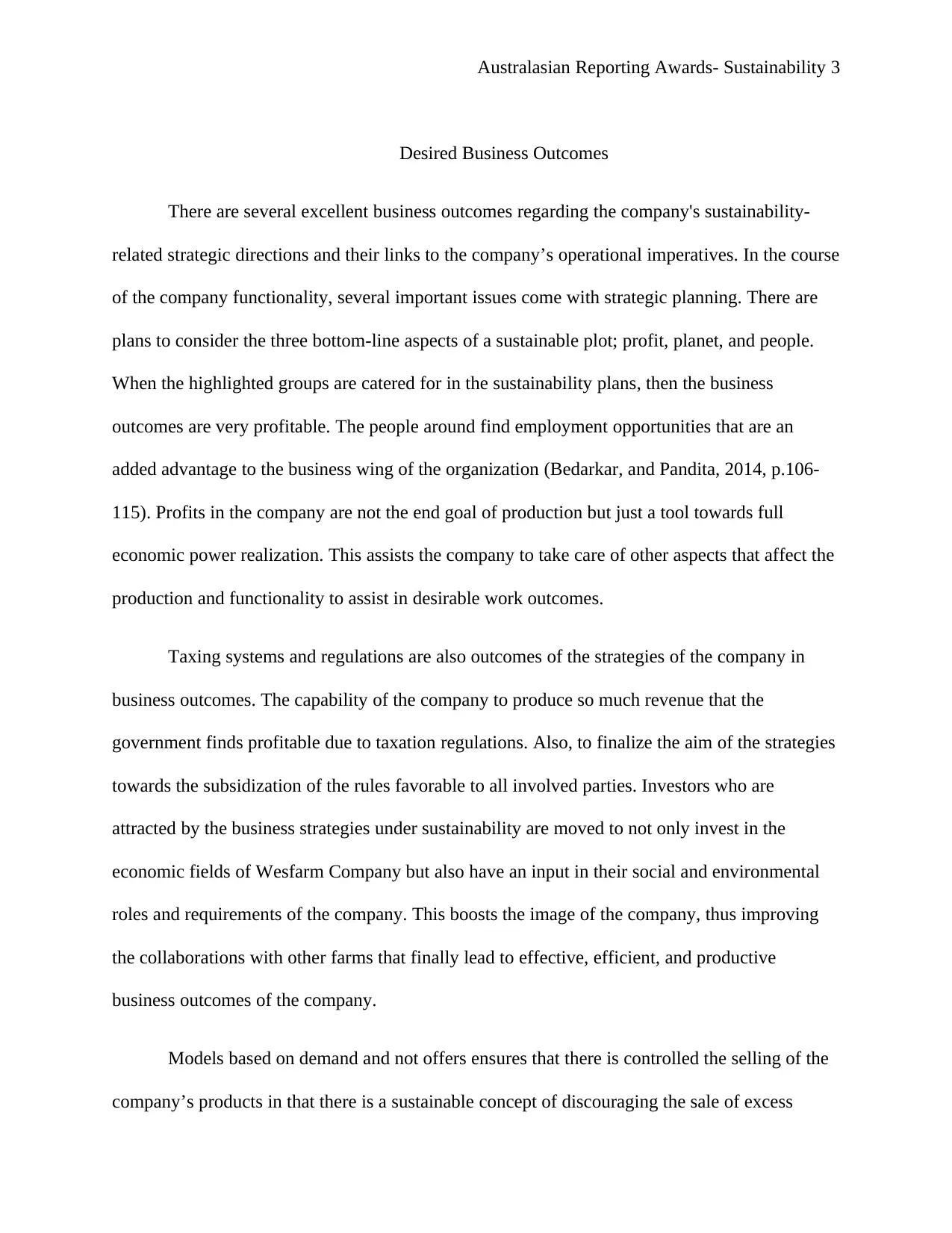
Australasian Reporting Awards- Sustainability 3
Desired Business Outcomes
There are several excellent business outcomes regarding the company's sustainability-
related strategic directions and their links to the company’s operational imperatives. In the course
of the company functionality, several important issues come with strategic planning. There are
plans to consider the three bottom-line aspects of a sustainable plot; profit, planet, and people.
When the highlighted groups are catered for in the sustainability plans, then the business
outcomes are very profitable. The people around find employment opportunities that are an
added advantage to the business wing of the organization (Bedarkar, and Pandita, 2014, p.106-
115). Profits in the company are not the end goal of production but just a tool towards full
economic power realization. This assists the company to take care of other aspects that affect the
production and functionality to assist in desirable work outcomes.
Taxing systems and regulations are also outcomes of the strategies of the company in
business outcomes. The capability of the company to produce so much revenue that the
government finds profitable due to taxation regulations. Also, to finalize the aim of the strategies
towards the subsidization of the rules favorable to all involved parties. Investors who are
attracted by the business strategies under sustainability are moved to not only invest in the
economic fields of Wesfarm Company but also have an input in their social and environmental
roles and requirements of the company. This boosts the image of the company, thus improving
the collaborations with other farms that finally lead to effective, efficient, and productive
business outcomes of the company.
Models based on demand and not offers ensures that there is controlled the selling of the
company’s products in that there is a sustainable concept of discouraging the sale of excess
Desired Business Outcomes
There are several excellent business outcomes regarding the company's sustainability-
related strategic directions and their links to the company’s operational imperatives. In the course
of the company functionality, several important issues come with strategic planning. There are
plans to consider the three bottom-line aspects of a sustainable plot; profit, planet, and people.
When the highlighted groups are catered for in the sustainability plans, then the business
outcomes are very profitable. The people around find employment opportunities that are an
added advantage to the business wing of the organization (Bedarkar, and Pandita, 2014, p.106-
115). Profits in the company are not the end goal of production but just a tool towards full
economic power realization. This assists the company to take care of other aspects that affect the
production and functionality to assist in desirable work outcomes.
Taxing systems and regulations are also outcomes of the strategies of the company in
business outcomes. The capability of the company to produce so much revenue that the
government finds profitable due to taxation regulations. Also, to finalize the aim of the strategies
towards the subsidization of the rules favorable to all involved parties. Investors who are
attracted by the business strategies under sustainability are moved to not only invest in the
economic fields of Wesfarm Company but also have an input in their social and environmental
roles and requirements of the company. This boosts the image of the company, thus improving
the collaborations with other farms that finally lead to effective, efficient, and productive
business outcomes of the company.
Models based on demand and not offers ensures that there is controlled the selling of the
company’s products in that there is a sustainable concept of discouraging the sale of excess
⊘ This is a preview!⊘
Do you want full access?
Subscribe today to unlock all pages.

Trusted by 1+ million students worldwide
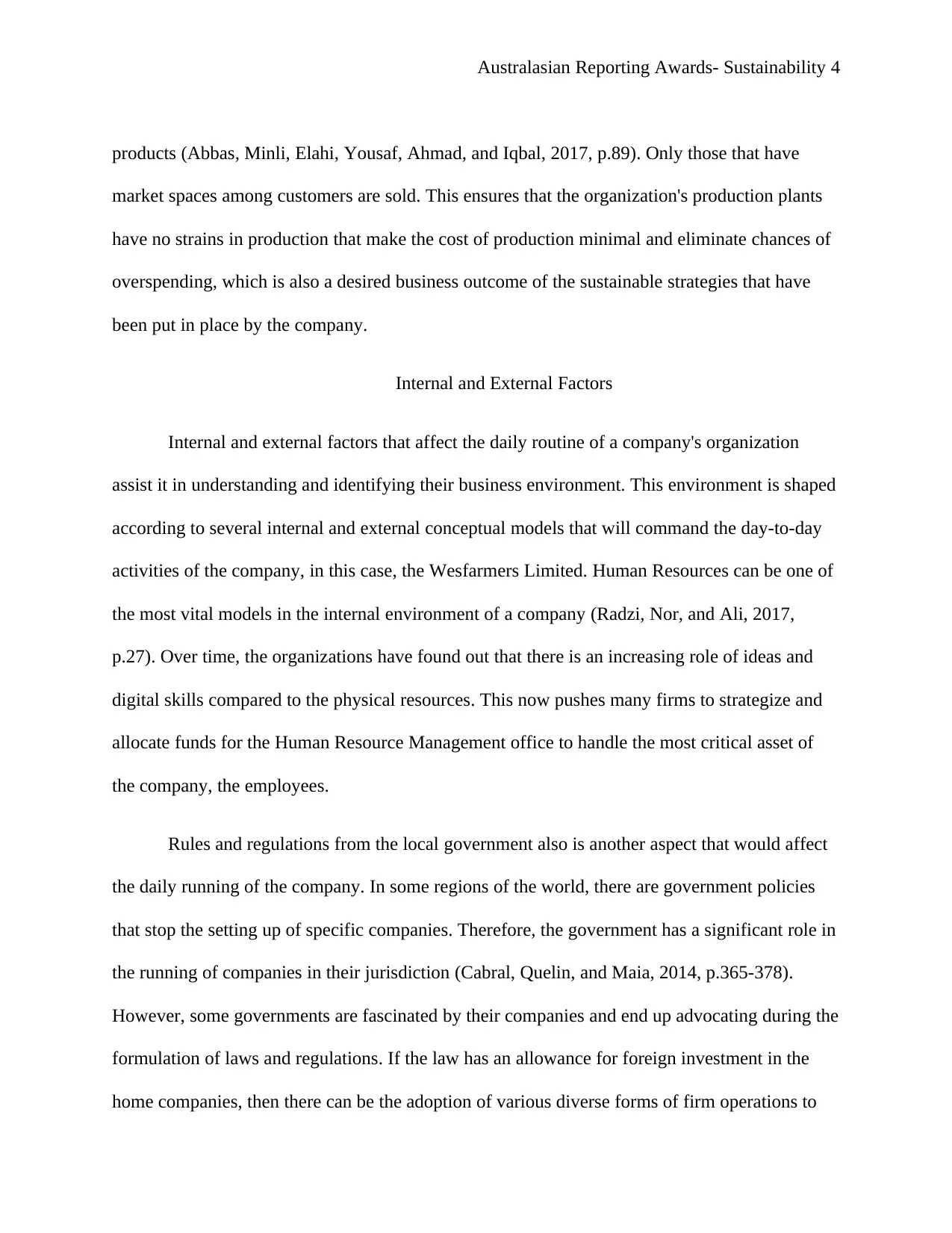
Australasian Reporting Awards- Sustainability 4
products (Abbas, Minli, Elahi, Yousaf, Ahmad, and Iqbal, 2017, p.89). Only those that have
market spaces among customers are sold. This ensures that the organization's production plants
have no strains in production that make the cost of production minimal and eliminate chances of
overspending, which is also a desired business outcome of the sustainable strategies that have
been put in place by the company.
Internal and External Factors
Internal and external factors that affect the daily routine of a company's organization
assist it in understanding and identifying their business environment. This environment is shaped
according to several internal and external conceptual models that will command the day-to-day
activities of the company, in this case, the Wesfarmers Limited. Human Resources can be one of
the most vital models in the internal environment of a company (Radzi, Nor, and Ali, 2017,
p.27). Over time, the organizations have found out that there is an increasing role of ideas and
digital skills compared to the physical resources. This now pushes many firms to strategize and
allocate funds for the Human Resource Management office to handle the most critical asset of
the company, the employees.
Rules and regulations from the local government also is another aspect that would affect
the daily running of the company. In some regions of the world, there are government policies
that stop the setting up of specific companies. Therefore, the government has a significant role in
the running of companies in their jurisdiction (Cabral, Quelin, and Maia, 2014, p.365-378).
However, some governments are fascinated by their companies and end up advocating during the
formulation of laws and regulations. If the law has an allowance for foreign investment in the
home companies, then there can be the adoption of various diverse forms of firm operations to
products (Abbas, Minli, Elahi, Yousaf, Ahmad, and Iqbal, 2017, p.89). Only those that have
market spaces among customers are sold. This ensures that the organization's production plants
have no strains in production that make the cost of production minimal and eliminate chances of
overspending, which is also a desired business outcome of the sustainable strategies that have
been put in place by the company.
Internal and External Factors
Internal and external factors that affect the daily routine of a company's organization
assist it in understanding and identifying their business environment. This environment is shaped
according to several internal and external conceptual models that will command the day-to-day
activities of the company, in this case, the Wesfarmers Limited. Human Resources can be one of
the most vital models in the internal environment of a company (Radzi, Nor, and Ali, 2017,
p.27). Over time, the organizations have found out that there is an increasing role of ideas and
digital skills compared to the physical resources. This now pushes many firms to strategize and
allocate funds for the Human Resource Management office to handle the most critical asset of
the company, the employees.
Rules and regulations from the local government also is another aspect that would affect
the daily running of the company. In some regions of the world, there are government policies
that stop the setting up of specific companies. Therefore, the government has a significant role in
the running of companies in their jurisdiction (Cabral, Quelin, and Maia, 2014, p.365-378).
However, some governments are fascinated by their companies and end up advocating during the
formulation of laws and regulations. If the law has an allowance for foreign investment in the
home companies, then there can be the adoption of various diverse forms of firm operations to
Paraphrase This Document
Need a fresh take? Get an instant paraphrase of this document with our AI Paraphraser
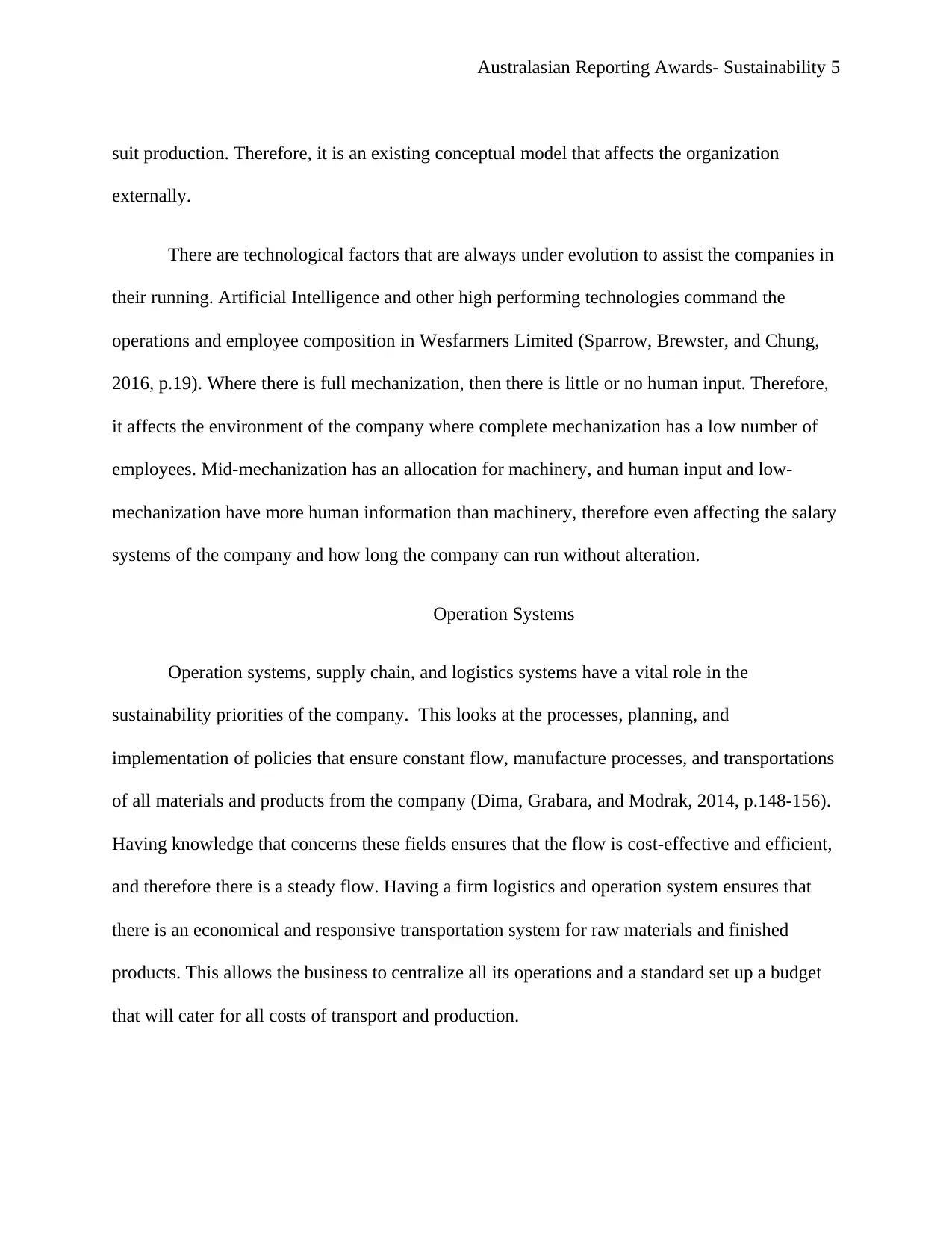
Australasian Reporting Awards- Sustainability 5
suit production. Therefore, it is an existing conceptual model that affects the organization
externally.
There are technological factors that are always under evolution to assist the companies in
their running. Artificial Intelligence and other high performing technologies command the
operations and employee composition in Wesfarmers Limited (Sparrow, Brewster, and Chung,
2016, p.19). Where there is full mechanization, then there is little or no human input. Therefore,
it affects the environment of the company where complete mechanization has a low number of
employees. Mid-mechanization has an allocation for machinery, and human input and low-
mechanization have more human information than machinery, therefore even affecting the salary
systems of the company and how long the company can run without alteration.
Operation Systems
Operation systems, supply chain, and logistics systems have a vital role in the
sustainability priorities of the company. This looks at the processes, planning, and
implementation of policies that ensure constant flow, manufacture processes, and transportations
of all materials and products from the company (Dima, Grabara, and Modrak, 2014, p.148-156).
Having knowledge that concerns these fields ensures that the flow is cost-effective and efficient,
and therefore there is a steady flow. Having a firm logistics and operation system ensures that
there is an economical and responsive transportation system for raw materials and finished
products. This allows the business to centralize all its operations and a standard set up a budget
that will cater for all costs of transport and production.
suit production. Therefore, it is an existing conceptual model that affects the organization
externally.
There are technological factors that are always under evolution to assist the companies in
their running. Artificial Intelligence and other high performing technologies command the
operations and employee composition in Wesfarmers Limited (Sparrow, Brewster, and Chung,
2016, p.19). Where there is full mechanization, then there is little or no human input. Therefore,
it affects the environment of the company where complete mechanization has a low number of
employees. Mid-mechanization has an allocation for machinery, and human input and low-
mechanization have more human information than machinery, therefore even affecting the salary
systems of the company and how long the company can run without alteration.
Operation Systems
Operation systems, supply chain, and logistics systems have a vital role in the
sustainability priorities of the company. This looks at the processes, planning, and
implementation of policies that ensure constant flow, manufacture processes, and transportations
of all materials and products from the company (Dima, Grabara, and Modrak, 2014, p.148-156).
Having knowledge that concerns these fields ensures that the flow is cost-effective and efficient,
and therefore there is a steady flow. Having a firm logistics and operation system ensures that
there is an economical and responsive transportation system for raw materials and finished
products. This allows the business to centralize all its operations and a standard set up a budget
that will cater for all costs of transport and production.
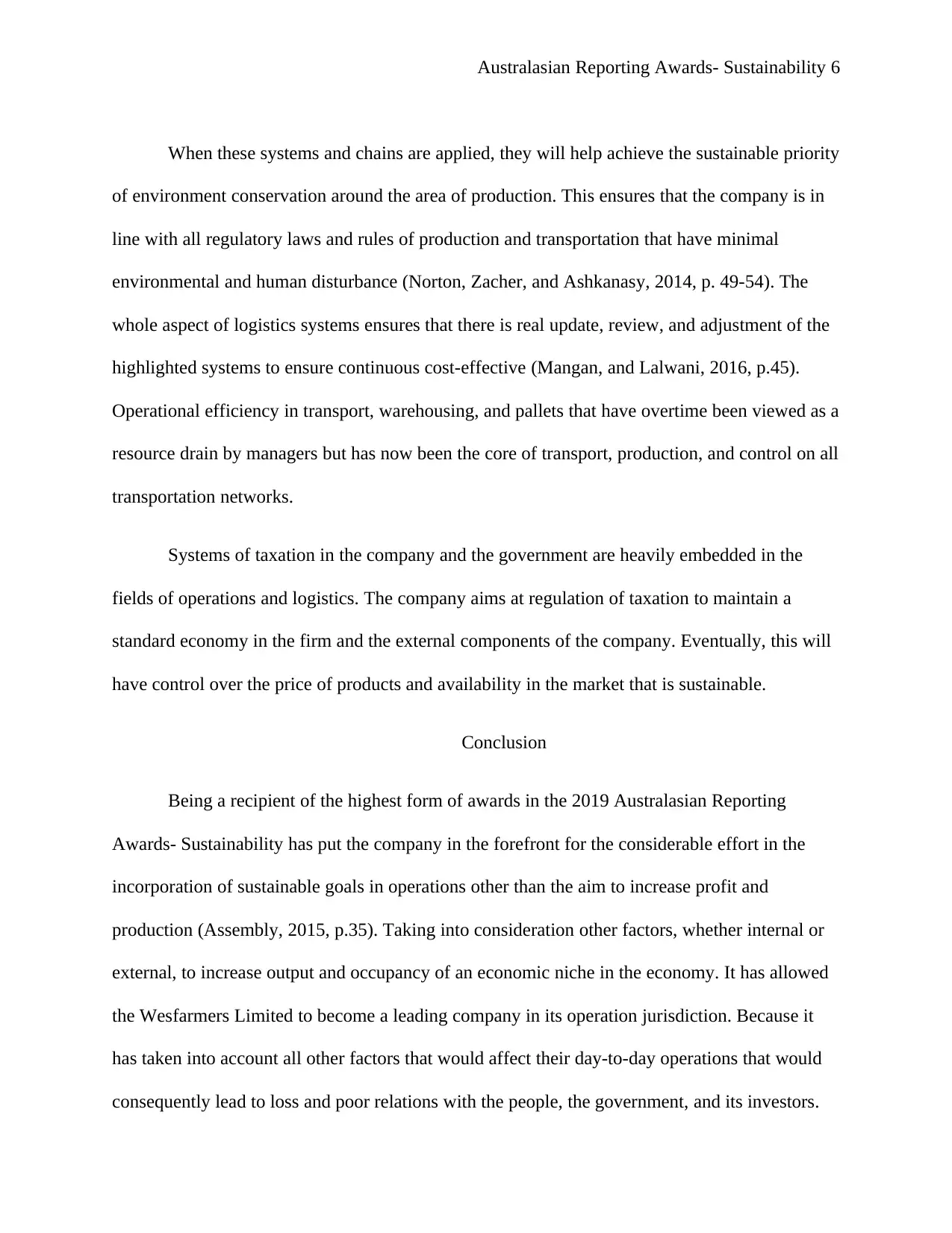
Australasian Reporting Awards- Sustainability 6
When these systems and chains are applied, they will help achieve the sustainable priority
of environment conservation around the area of production. This ensures that the company is in
line with all regulatory laws and rules of production and transportation that have minimal
environmental and human disturbance (Norton, Zacher, and Ashkanasy, 2014, p. 49-54). The
whole aspect of logistics systems ensures that there is real update, review, and adjustment of the
highlighted systems to ensure continuous cost-effective (Mangan, and Lalwani, 2016, p.45).
Operational efficiency in transport, warehousing, and pallets that have overtime been viewed as a
resource drain by managers but has now been the core of transport, production, and control on all
transportation networks.
Systems of taxation in the company and the government are heavily embedded in the
fields of operations and logistics. The company aims at regulation of taxation to maintain a
standard economy in the firm and the external components of the company. Eventually, this will
have control over the price of products and availability in the market that is sustainable.
Conclusion
Being a recipient of the highest form of awards in the 2019 Australasian Reporting
Awards- Sustainability has put the company in the forefront for the considerable effort in the
incorporation of sustainable goals in operations other than the aim to increase profit and
production (Assembly, 2015, p.35). Taking into consideration other factors, whether internal or
external, to increase output and occupancy of an economic niche in the economy. It has allowed
the Wesfarmers Limited to become a leading company in its operation jurisdiction. Because it
has taken into account all other factors that would affect their day-to-day operations that would
consequently lead to loss and poor relations with the people, the government, and its investors.
When these systems and chains are applied, they will help achieve the sustainable priority
of environment conservation around the area of production. This ensures that the company is in
line with all regulatory laws and rules of production and transportation that have minimal
environmental and human disturbance (Norton, Zacher, and Ashkanasy, 2014, p. 49-54). The
whole aspect of logistics systems ensures that there is real update, review, and adjustment of the
highlighted systems to ensure continuous cost-effective (Mangan, and Lalwani, 2016, p.45).
Operational efficiency in transport, warehousing, and pallets that have overtime been viewed as a
resource drain by managers but has now been the core of transport, production, and control on all
transportation networks.
Systems of taxation in the company and the government are heavily embedded in the
fields of operations and logistics. The company aims at regulation of taxation to maintain a
standard economy in the firm and the external components of the company. Eventually, this will
have control over the price of products and availability in the market that is sustainable.
Conclusion
Being a recipient of the highest form of awards in the 2019 Australasian Reporting
Awards- Sustainability has put the company in the forefront for the considerable effort in the
incorporation of sustainable goals in operations other than the aim to increase profit and
production (Assembly, 2015, p.35). Taking into consideration other factors, whether internal or
external, to increase output and occupancy of an economic niche in the economy. It has allowed
the Wesfarmers Limited to become a leading company in its operation jurisdiction. Because it
has taken into account all other factors that would affect their day-to-day operations that would
consequently lead to loss and poor relations with the people, the government, and its investors.
⊘ This is a preview!⊘
Do you want full access?
Subscribe today to unlock all pages.

Trusted by 1+ million students worldwide
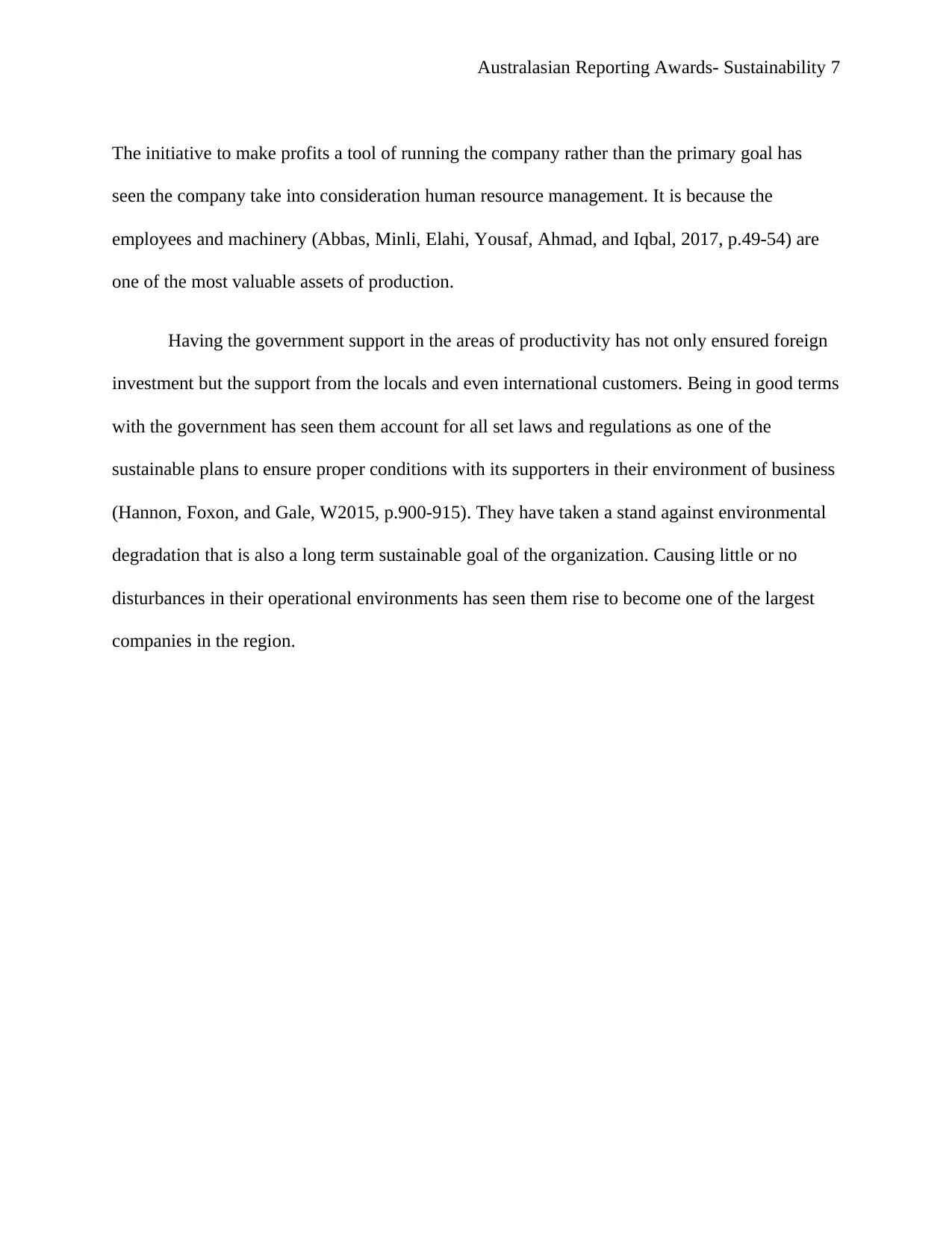
Australasian Reporting Awards- Sustainability 7
The initiative to make profits a tool of running the company rather than the primary goal has
seen the company take into consideration human resource management. It is because the
employees and machinery (Abbas, Minli, Elahi, Yousaf, Ahmad, and Iqbal, 2017, p.49-54) are
one of the most valuable assets of production.
Having the government support in the areas of productivity has not only ensured foreign
investment but the support from the locals and even international customers. Being in good terms
with the government has seen them account for all set laws and regulations as one of the
sustainable plans to ensure proper conditions with its supporters in their environment of business
(Hannon, Foxon, and Gale, W2015, p.900-915). They have taken a stand against environmental
degradation that is also a long term sustainable goal of the organization. Causing little or no
disturbances in their operational environments has seen them rise to become one of the largest
companies in the region.
The initiative to make profits a tool of running the company rather than the primary goal has
seen the company take into consideration human resource management. It is because the
employees and machinery (Abbas, Minli, Elahi, Yousaf, Ahmad, and Iqbal, 2017, p.49-54) are
one of the most valuable assets of production.
Having the government support in the areas of productivity has not only ensured foreign
investment but the support from the locals and even international customers. Being in good terms
with the government has seen them account for all set laws and regulations as one of the
sustainable plans to ensure proper conditions with its supporters in their environment of business
(Hannon, Foxon, and Gale, W2015, p.900-915). They have taken a stand against environmental
degradation that is also a long term sustainable goal of the organization. Causing little or no
disturbances in their operational environments has seen them rise to become one of the largest
companies in the region.
Paraphrase This Document
Need a fresh take? Get an instant paraphrase of this document with our AI Paraphraser
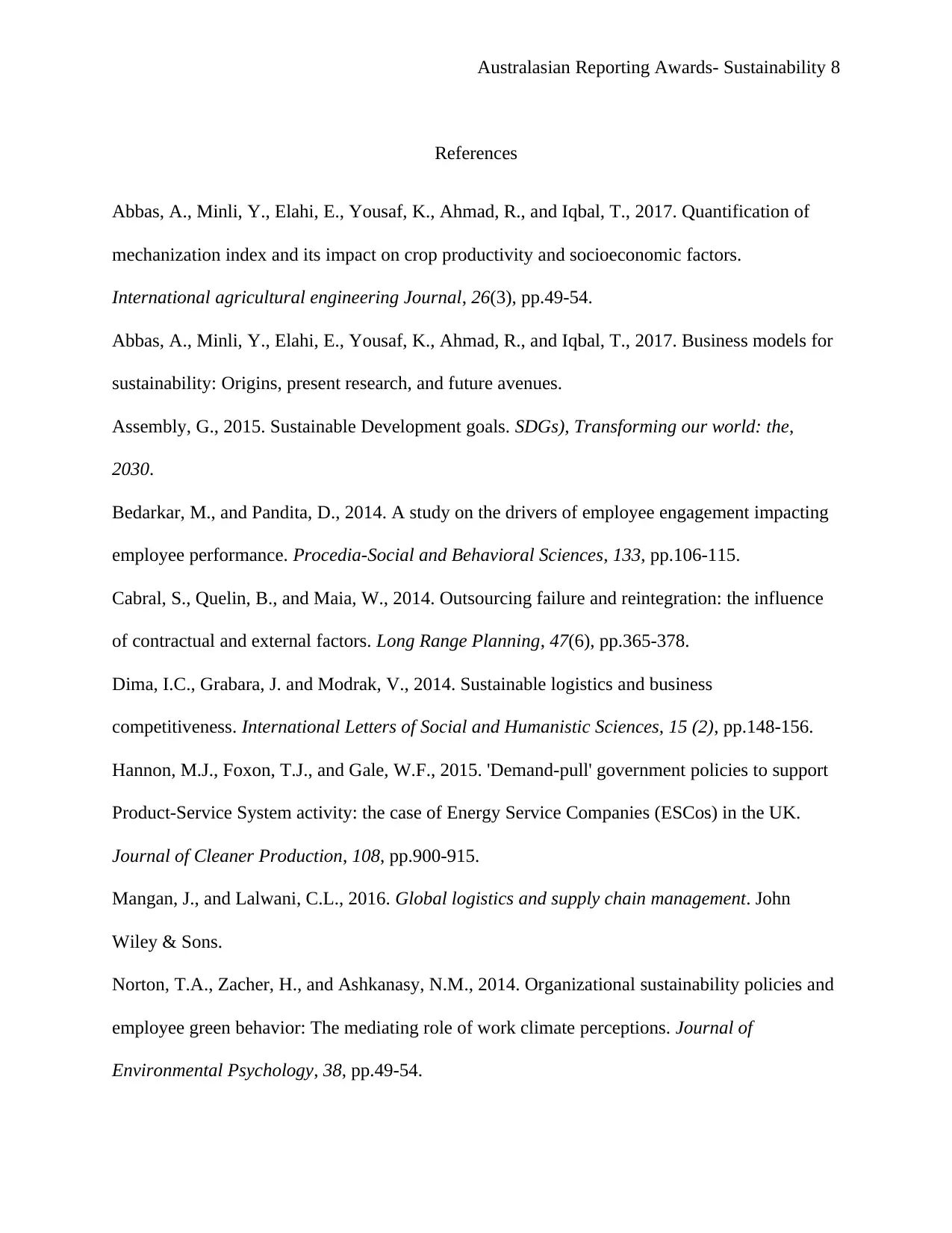
Australasian Reporting Awards- Sustainability 8
References
Abbas, A., Minli, Y., Elahi, E., Yousaf, K., Ahmad, R., and Iqbal, T., 2017. Quantification of
mechanization index and its impact on crop productivity and socioeconomic factors.
International agricultural engineering Journal, 26(3), pp.49-54.
Abbas, A., Minli, Y., Elahi, E., Yousaf, K., Ahmad, R., and Iqbal, T., 2017. Business models for
sustainability: Origins, present research, and future avenues.
Assembly, G., 2015. Sustainable Development goals. SDGs), Transforming our world: the,
2030.
Bedarkar, M., and Pandita, D., 2014. A study on the drivers of employee engagement impacting
employee performance. Procedia-Social and Behavioral Sciences, 133, pp.106-115.
Cabral, S., Quelin, B., and Maia, W., 2014. Outsourcing failure and reintegration: the influence
of contractual and external factors. Long Range Planning, 47(6), pp.365-378.
Dima, I.C., Grabara, J. and Modrak, V., 2014. Sustainable logistics and business
competitiveness. International Letters of Social and Humanistic Sciences, 15 (2), pp.148-156.
Hannon, M.J., Foxon, T.J., and Gale, W.F., 2015. 'Demand-pull' government policies to support
Product-Service System activity: the case of Energy Service Companies (ESCos) in the UK.
Journal of Cleaner Production, 108, pp.900-915.
Mangan, J., and Lalwani, C.L., 2016. Global logistics and supply chain management. John
Wiley & Sons.
Norton, T.A., Zacher, H., and Ashkanasy, N.M., 2014. Organizational sustainability policies and
employee green behavior: The mediating role of work climate perceptions. Journal of
Environmental Psychology, 38, pp.49-54.
References
Abbas, A., Minli, Y., Elahi, E., Yousaf, K., Ahmad, R., and Iqbal, T., 2017. Quantification of
mechanization index and its impact on crop productivity and socioeconomic factors.
International agricultural engineering Journal, 26(3), pp.49-54.
Abbas, A., Minli, Y., Elahi, E., Yousaf, K., Ahmad, R., and Iqbal, T., 2017. Business models for
sustainability: Origins, present research, and future avenues.
Assembly, G., 2015. Sustainable Development goals. SDGs), Transforming our world: the,
2030.
Bedarkar, M., and Pandita, D., 2014. A study on the drivers of employee engagement impacting
employee performance. Procedia-Social and Behavioral Sciences, 133, pp.106-115.
Cabral, S., Quelin, B., and Maia, W., 2014. Outsourcing failure and reintegration: the influence
of contractual and external factors. Long Range Planning, 47(6), pp.365-378.
Dima, I.C., Grabara, J. and Modrak, V., 2014. Sustainable logistics and business
competitiveness. International Letters of Social and Humanistic Sciences, 15 (2), pp.148-156.
Hannon, M.J., Foxon, T.J., and Gale, W.F., 2015. 'Demand-pull' government policies to support
Product-Service System activity: the case of Energy Service Companies (ESCos) in the UK.
Journal of Cleaner Production, 108, pp.900-915.
Mangan, J., and Lalwani, C.L., 2016. Global logistics and supply chain management. John
Wiley & Sons.
Norton, T.A., Zacher, H., and Ashkanasy, N.M., 2014. Organizational sustainability policies and
employee green behavior: The mediating role of work climate perceptions. Journal of
Environmental Psychology, 38, pp.49-54.
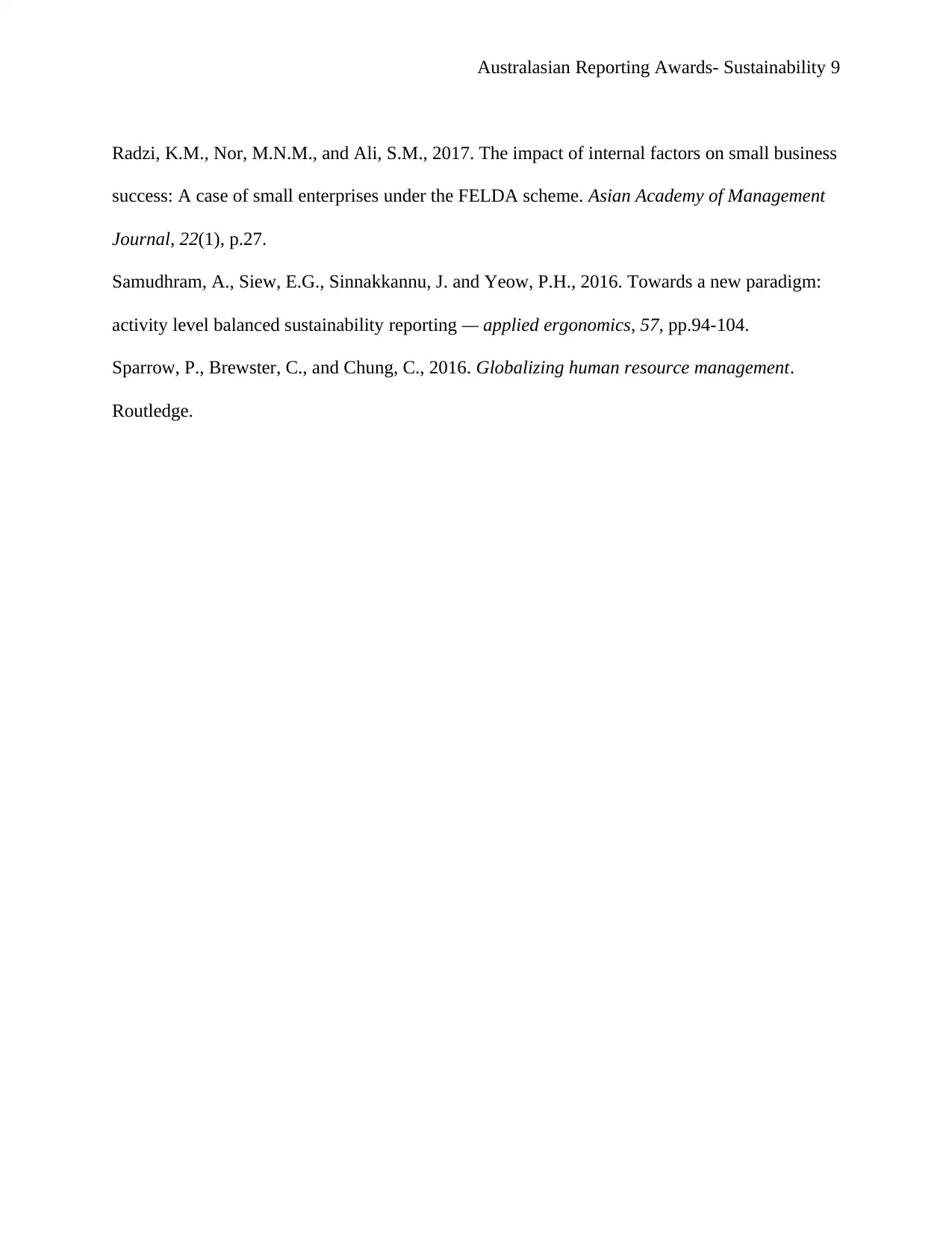
Australasian Reporting Awards- Sustainability 9
Radzi, K.M., Nor, M.N.M., and Ali, S.M., 2017. The impact of internal factors on small business
success: A case of small enterprises under the FELDA scheme. Asian Academy of Management
Journal, 22(1), p.27.
Samudhram, A., Siew, E.G., Sinnakkannu, J. and Yeow, P.H., 2016. Towards a new paradigm:
activity level balanced sustainability reporting — applied ergonomics, 57, pp.94-104.
Sparrow, P., Brewster, C., and Chung, C., 2016. Globalizing human resource management.
Routledge.
Radzi, K.M., Nor, M.N.M., and Ali, S.M., 2017. The impact of internal factors on small business
success: A case of small enterprises under the FELDA scheme. Asian Academy of Management
Journal, 22(1), p.27.
Samudhram, A., Siew, E.G., Sinnakkannu, J. and Yeow, P.H., 2016. Towards a new paradigm:
activity level balanced sustainability reporting — applied ergonomics, 57, pp.94-104.
Sparrow, P., Brewster, C., and Chung, C., 2016. Globalizing human resource management.
Routledge.
⊘ This is a preview!⊘
Do you want full access?
Subscribe today to unlock all pages.

Trusted by 1+ million students worldwide
1 out of 9
Related Documents
Your All-in-One AI-Powered Toolkit for Academic Success.
+13062052269
info@desklib.com
Available 24*7 on WhatsApp / Email
![[object Object]](/_next/static/media/star-bottom.7253800d.svg)
Unlock your academic potential
Copyright © 2020–2025 A2Z Services. All Rights Reserved. Developed and managed by ZUCOL.



